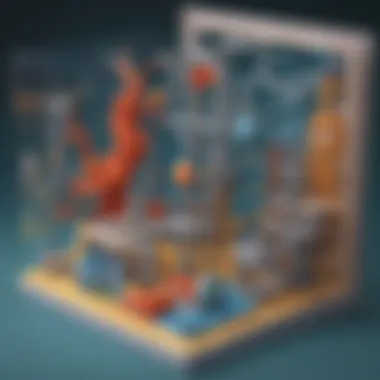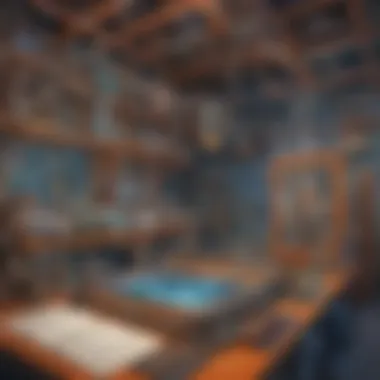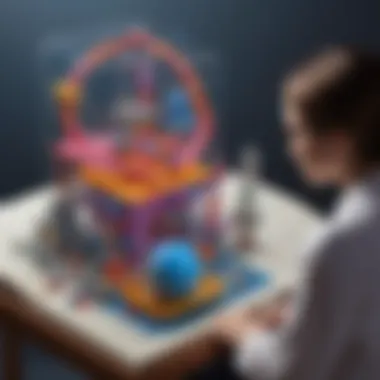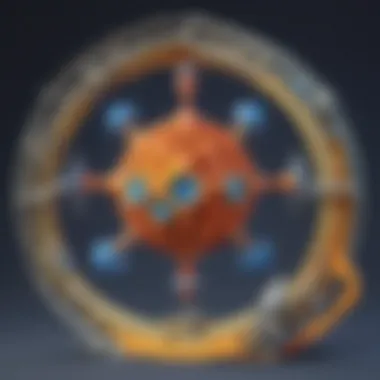Exploring Science Through 3D Modeling Innovations


Intro
As we navigate through the ever-evolving landscape of education, one tool stands out for its transformative potential: 3D modeling. This innovative approach not only enhances understanding of intricate scientific concepts but also makes learning a more engaging experience for young minds.
In this article, we will delve into how 3D modeling is changing the way science is taught and learned. We will explore its applications across various scientific domains, from biology to physics, and highlight the benefits it brings to classrooms. By the end, you will gain insights into effective methods for incorporating these models into your educational toolkit.
Prelude to 3D Modeling in Science
3D modeling represents a significant leap in how science is taught and understood. It provides a unique approach that allows learners to visualize complex concepts in a tangible manner. By creating three-dimensional representations of scientific entities, students can better grasp ideas that traditionally require abstract thinking.
Definition of 3D Modeling
3D modeling involves creating a digital representation of a physical object or environment. This process employs computer software to develop models that reflect real-world features. The result is an immersive experience where users can rotate, zoom, and manipulate the model, enhancing comprehension. In education, 3D models can represent various scientific phenomena, from molecular structures in chemistry to anatomical features in biology.
The Evolution of 3D Technology
Over the years, 3D modeling technology has undergone remarkable advancements. Initially developed for industries like film and gaming, its application expanded into education as software became more accessible. Today, platforms such as Blender and Tinkercad allow both educators and students to create models with relative ease. The evolution of Virtual Reality (VR) has further transformed this field, enabling immersive learning experiences that engage students like never before.
Importance of 3D Models in Science Education
The pedagogical benefits of 3D models in science education are multifold. Firstly, they promote visual learning, making abstract information concrete. Secondly, they encourage interactive engagement, allowing students to explore materials actively rather than passively receiving information. This has been shown to enhance retention and understanding.
Thirdly, 3D models facilitate conceptual understanding. For example, examining the structure of a cell model can help students visualize organelles' functions. Understanding these elements fosters a deeper appreciation for biological systems. Ultimately, incorporating 3D modeling into science education not only enriches the learning experience but also prepares students for future advancements in technology.
Applications of 3D Models in Various Scientific Fields
The use of 3D models spans many scientific fields. These models provide dynamic ways to present complex ideas. They are not only useful for demonstration purposes but also enhance the overall understanding of scientific principles. By visualizing information in three dimensions, learners can dive deeper into content. This method encourages exploration and critical thinking in students.
3D Models in Biology
Understanding Cellular Structures
Understanding cellular structures is fundamental in biology. 3D models allow learners to visualize cells in great detail. Instead of reading descriptions, students can see the parts of a cell. Features such as the nucleus, mitochondria, and membrane become clear. This visual representation aids in comprehension. One key characteristic is the way complex cell functions are simplified. This simplicity makes 3D models a popular choice in biology education.
The unique feature of these models lies in their interactivity. Students can manipulate them to see how parts work together. The advantages include better retention of information. However, a disadvantage could be technical difficulties that some learners may face.
Visualizing Ecosystems
Visualizing ecosystems through 3D models opens new ways to study interconnectivity. This method helps students understand how organisms interact. It highlights food chains, habitats, and biodiversity. A prominent advantage is the immersive experience. Students feel as if they are part of the ecosystem.
A unique feature is the ability to simulate changes in the ecosystem due to human impact. This provides an enriched perspective on conservation issues. Though beneficial, this method may require more resources, which could be a challenge for some classrooms.
3D Models in Chemistry
Interpreting Molecular Structures
Interpreting molecular structures is crucial for understanding chemistry. 3D models allow for a clearer view of how atoms bond. This visual clarity helps students grasp complex ideas. A key characteristic of these models is their ability to show spatial arrangements.
This is advantageous because it enhances students' ability to visualize chemical reactions. A potential downside is that intricate models may overwhelm novice learners. Keeping explanations simple becomes important.
Simulating Chemical Reactions


Simulating chemical reactions with 3D models brings theory to life. Students can observe how reactions occur in real-time. This application leads to a better understanding of kinesthetics in chemistry. A major strength is the hands-on experience students receive. They can manipulate variables and observe outcomes.
However, one downside is that simulation software might not always be accessible. Schools may struggle with funding for advanced resources. Such challenges can limit exposure to these innovative methodologies.
3D Models in Physics
Exploring Forces and Motion
Exploring forces and motion through 3D modeling enables students to visualize concepts like gravity and friction. Through models, learners can see the effect of these forces firsthand. This aspect is beneficial as it grounds abstract concepts in reality.
The unique feature of this approach is offering a tactile experience of physics principles. Students can feel how forces interact when performing an experiment. Nonetheless, some models might be too advanced, potentially discouraging younger learners.
Understanding Energy Transformation
Understanding energy transformation requires comprehensive demonstration. 3D models can illustrate how energy changes from one form to another. This topic is crucial in physics and with the use of models, students can follow complex processes clearly.
One key characteristic is the detailed depiction of systems involved, such as in machines. This clarity can significantly aid in learners’ comprehension. However, the downside could be the time necessary to master the models and concepts.
3D Models in Earth Sciences
Modeling Geological Processes
Modeling geological processes with 3D representations is invaluable to Earth sciences. It allows students to understand phenomena like plate tectonics and erosion. A significant characteristic of these models is their ability to show layers and timelines.
This approach benefits learners by giving context over time. They can visualize how landscapes have changed or developed. However, some models may misrepresent minor details which can lead to misconceptions. Accuracy in depiction becomes essential to avoid confusion.
Visualizing Climate Change Effects
Visualizing climate change effects in 3D is not just educational; it's crucial for awareness. Students can see the direct consequences of climate issues like rising sea levels. A key feature is the capacity to depict long-term changes vividly. This can be eye-opening and impactful for young minds.
While this application has a powerful advantage in raising environmental awareness, the challenge comes with ensuring the models are realistic. They must reflect current data accurately to maintain credibility.
Using 3D models across various scientific fields enhances engagement and fosters deeper understanding among students, making complex topics more accessible.
Benefits of Using 3D Models in Science Learning
The advent of 3D models in science education delivers significant advantages. These benefits extend beyond mere visual appeal. They empower students to grasp complex ideas with clarity and depth. In addition, they foster a more engaging learning atmosphere. The implications of using 3D models in science education are profound, particularly for elementary school children, parents, and caregivers.
Enhancing Visual Learning
Visual learning is a critical component of education, especially in science. Children often struggle to understand abstract concepts when presented with text and images alone. 3D models provide a tangible representation of complex ideas. For example, when studying the human body, a 3D model allows students to see organ placement and function clearly. This is far more effective than flat illustrations.
Using 3D models can enhance student retention of information. Studies demonstrate that students remember information better when they can visualize it. This approach transforms theoretical knowledge into concrete comprehension. It allows for exploration of concepts that are otherwise difficult to visualize.
Promoting Interactive Engagement
3D models promote a hands-on learning experience. Children excel in environments where they can interact with the material. By allowing students to manipulate these models, educators encourage active participation in lessons. This interaction sparks curiosity and hones critical thinking skills. When students engage in activities such as rotating models or dissecting them, they gain a deeper understanding of the subject matter.
Furthermore, interactive learning can cater to various learning styles. Visual, kinesthetic, and auditory learners can all benefit from 3D models. This adaptability enhances the educational experience for each child, supporting inclusive learning.
Facilitating Conceptual Understanding


The complexity of scientific concepts often poses challenges for students. However, 3D modeling serves as a bridge. It facilitates understanding by simplifying complex systems. For instance, understanding weather patterns can be challenging. On a flat surface, such concepts may appear convoluted. Yet, with a 3D visualization of the atmosphere, learners can see layer interactions in a more coherent way.
Moreover, 3D models allow for experimentation in a controlled environment. Students can simulate different scenarios, such as chemical reactions or ecological systems. This experimentation fosters a hands-on approach that enhances conceptual grasp. Children learn not just by memorizing facts but also by experiencing them.
These benefits establish a foundation for effective learning strategies in science classrooms. As educators explore the integration of 3D models, they will witness transformative impacts on student understanding and interest in science.
Integrating 3D Models in the Classroom
Integrating 3D models into the classroom is vital for the evolution of science education. This process not only enriches the curriculum but also engages students by making complex concepts accessible. Utilizing 3D technology helps foster a more interactive learning environment. It stimulates curiosity and motivates learners to explore topics in greater depth. Engaging with 3D models allows students to visualize scientific phenomena that might otherwise be abstract. As such, it becomes a key strategy in modern pedagogical approaches.
Choosing the Right Tools
Software Applications
Software applications play a significant role in the effective integration of 3D models in classrooms. Platforms like Tinkercad and Blender offer user-friendly interfaces that are suitable for various educational levels. One key characteristic of these applications is their ability to facilitate the design and manipulation of 3D objects. This hands-on experience cultivates creativity while allowing students to grasp technical skills.
A unique feature of Tinkercad is its online accessibility, enabling students to collaborate easily regardless of location. This collaboration fosters a sense of community and encourages peer-to-peer learning. However, the learning curve for software like Blender might be steep for younger students, possibly causing frustration before they gain proficiency.
Hardware Requirements
The hardware requirements necessary for 3D modeling in classrooms are essential to consider for a successful implementation. Reliable computers and tablets with appropriate graphics capabilities are crucial for running complex 3D modeling software. A key characteristic of hardware in this context is its capability to support immersive experiences, such as virtual reality headsets.
Utilizing devices with advanced graphics ensures that students can experience high-quality visuals, which can enhance understanding. Devices like the Oculus Quest provide a unique exploration opportunity that can be captivating and informative. However, the costs associated with these setups can be prohibitive for some schools, creating inequities in access to these valuable educational tools.
Creating Effective Lesson Plans
Creating lesson plans that effectively incorporate 3D modeling requires thoughtful preparation. Educators must align 3D activities with learning objectives to meet curricular standards. This may include defining clear goals for student outcomes. Project-based learning can be particularly useful, as students could design their models based on real-world scientific problems. The emphasis here should be on practical applications that connect the models to their lives, making science more relevant and engaging.
Assessing Student Understanding
Formative Assessment Techniques
Formative assessment techniques are vital for gauging student comprehension during the learning process. These include quizzes, peer assessments, and group discussions that occur throughout the project lifecycle. Such ongoing evaluations allow for immediate feedback, helping educators refine their teaching approaches. A key characteristic is the adaptability of these assessments, which can cater to diverse learning styles. This flexibility makes formative assessments a beneficial choice in the integration of 3D models.
A unique feature of using formative assessments in this context is that they can provide insights into student thought processes. This information helps tailor guidance and support. Nonetheless, educators must balance these assessments with the models’ complexity, as excessive evaluation could detract from the learning experience.
Summative Evaluation Methods
Summative evaluation methods, in contrast, assess student knowledge at the end of a learning period. Techniques such as projects, presentations, or tests help measure how well students have grasped the content. The key characteristic of these evaluations is their focus on overall achievement in comparison to pre-set learning objectives. This immediately demonstrates the effectiveness of integrating 3D models into the curriculum.
A unique feature of summative evaluations is their ability to provide measurable outcomes through tangible student work, such as presentations of their 3D models. However, it is essential to avoid overly complex evaluations, which may not accurately reflect a student's understanding if they struggle with presentation skills.
Integrating 3D modeling throughout science education enhances student engagement and comprehension of complex topics. Ensuring the right tools and assessment strategies are in place is essential for maximizing this potential.
Challenges in Implementing 3D Models
Incorporating 3D models into science education presents several challenges that must be understood and addressed to fully harness their educational potential. These obstacles can affect the effectiveness of their usage in the classroom. Addressing these challenges is essential for educators, school administrators, and policymakers who aim to leverage technology to improve student engagement and comprehension.
Technical Limitations
One of the prominent issues is technical limitations. Many schools may lack the necessary hardware or software to create or display 3D models effectively. High-quality 3D modeling often requires powerful computers and specific applications, which may not be available in all educational settings. Moreover, the compatibility of software with existing systems can pose additional difficulties. Not all applications run smoothly on older machines, which may lead to frustrating experiences for both teachers and students.


Additionally, there may be limitations regarding internet connectivity. Reliable internet access is crucial for utilizing cloud-based modeling applications or downloading 3D resources. Schools in remote or underserved areas may struggle with such access, which limits their ability to implement innovative technologies.
Cost Considerations
Cost can be another significant barrier. Implementing 3D modeling tools involves various expenses, including purchasing software licenses, upgrading hardware, and investing in training sessions for educators. For many school districts, budget constraints make it difficult to allocate funds to these technologies, despite their potential benefits.
Moreover, educational institutions may have to consider the long-term costs associated with maintaining and updating the tools. This aspect includes budgeting for possible subscription fees for software and periodic hardware upgrades. Established programs can require substantial investments that are not always justifiable in terms of immediate educational outcomes.
Teacher Training Needs
Lastly, teacher training needs play a crucial role in the implementation of 3D models. Even if the technical requirements and costs are met, without proper training, educators may not feel confident using these tools effectively.
Training is essential for teachers to understand how to utilize 3D modeling in their lessons. It also helps them to integrate these tools with existing curriculums. Inadequate training can lead to underutilization or misuse of 3D technology, which diminishes its potential impact on students. Furthermore, ongoing professional development is necessary to keep teachers updated on advancements in 3D technology and pedagogy.
3D models can transform student engagement in science, but we must address the barriers to implement them successfully.
In summary, while 3D modeling holds the promise of revolutionizing science education, significant challenges still exist. Recognizing these challenges can help educators and institutions create strategies to overcome them, ensuring that all students benefit from innovative learning experiences.
Future of 3D Modeling in Science Education
The future of 3D modeling in science education holds immense potential. As technology evolves, it becomes crucial to examine the role of 3D models in shaping educational practices. These advancements can significantly improve understanding in scientific fields. The integration of 3D modeling brings forth several benefits and considerations that educators, parents, and students must explore.
Advancements in Technology
The rapid growth of technology catalyzes the advancement of 3D modeling. Tools and software have become more accessible and user-friendly. Programs like Tinkercad and Blender allow users to create detailed models with ease. These advancements enable students to visualize complex structures in science, which enhances cognitive processing.
Additionally, virtual and augmented reality technologies are becoming prevalent. They offer immersive experiences in which students can interact with three-dimensional representations. This interaction deepens comprehension, as learners can manipulate and explore models directly.
Moreover, cloud computing enables collaborative projects, allow students to share and access models remotely. This can empower learners, facilitating peer-to-peer learning and enhancing teamwork skills. The convergence of these technologies signifies a more engaging future in science education.
Increased Focus on STEM Education
With the global economy increasingly reliant on technology, there is a marked emphasis on Science, Technology, Engineering, and Mathematics (STEM) education. 3D modeling plays a crucial role in meeting this demand. Schools are increasingly adopting interdisciplinary approaches that incorporate 3D modeling in teaching methodologies.
This focus on STEM encourages creativity and problem-solving. For instance, a lesson may involve using 3D modeling to design a sustainable habitat. Students will not only learn about biology but also apply engineering principles in their designs.
Teachers can also use 3D models to demonstrate scientific phenomena. This practical application makes abstract concepts more tangible, aiding in better retention of information. By successfully integrating 3D modeling into STEM education, students gain skills that are vital in today's job market.
Potential for Global Collaboration
The capability of 3D modeling to facilitate global collaboration cannot be overlooked. Students from different countries can work on shared projects. This fosters cultural awareness and develops teamwork skills. For instance, learners can collaborate on environmental issues using 3D models, understanding how different regions may approach similar problems.
Such collaboration is made easier through digital platforms. Students can connect with peers around the world. They can share their 3D models, discuss varying solutions, and learn from one another’s perspectives. This global partnership cultivates a sense of belonging in a larger scientific community.
Culmination
In summarizing this exploration of 3D modeling in science education, it is crucial to recognize how these models facilitate deeper understanding of scientific concepts. The ability to visualize complex structures, such as the intricacies of cellular biology or the vastness of ecological systems, greatly enhances the learning experience. Learning through 3D models is not merely the addition of technology in classrooms, but a transformative approach that bridges gaps between theory and real-world applications.
Summarizing Key Points
A few significant elements emerge throughout this article:
- Interactive Learning: 3D models provide an immersive experience that engages students actively. This interaction is fundamental in retaining information and understanding complex subjects.
- Visual Comprehension: Visualizing scientific phenomena leads to better retention and comprehension. This is especially applicable in topics that are abstract or not easily observable.
- Diverse Applications: The versatility of 3D models spans multiple fields. From biology to Earth sciences, each discipline benefits from enhanced visual tools.
- Educator Resources: This article discusses strategies for teachers. It highlights tools, lesson plans, and assessment methods that make implementation of 3D modeling more manageable.
Encouraging Exploration
Looking ahead, educators, parents, and children themselves are urged to embrace 3D modeling as a valuable educational tool. They should seek out opportunities to incorporate these resources in both classroom settings and at home. By engaging with platforms like Blender, Tinkercad, or even exploring resources on websites like britannica.com or wikipedia.org, one can discover vast libraries of 3D models tailored for different educational levels.
Fostering a culture of inquiry and exploration among children is essential. 3D modeling offers a unique avenue for exploration that merges creativity with education. As children interact with 3D models, they develop critical thinking and problem-solving skills. This passion for science can lead them to become innovators of the future, making it essential for guardians to provide them with the opportunities to explore these dimensions.







